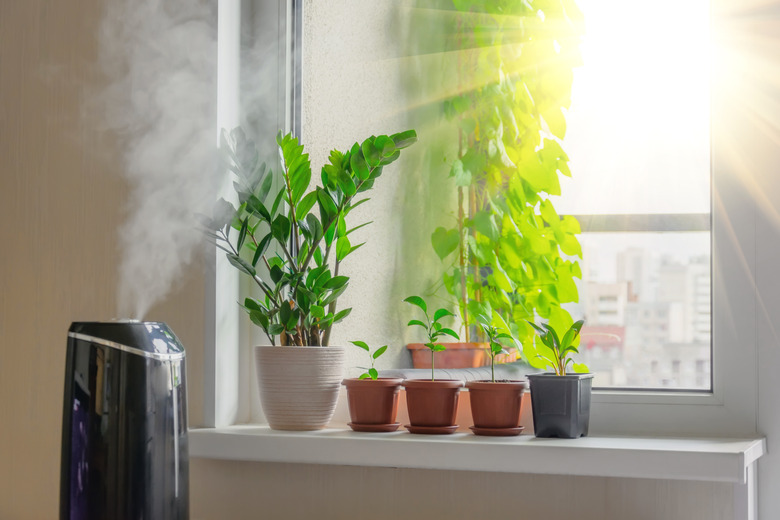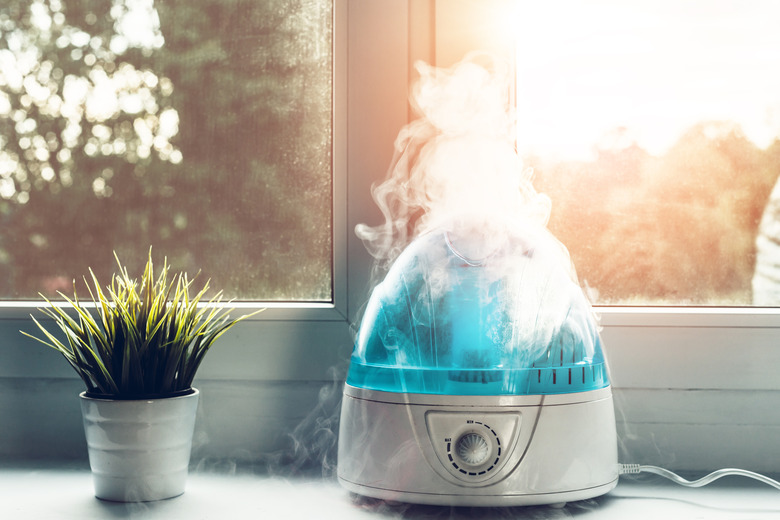Whole-House Humidifiers Vs. Portable Humidifiers: Which Is Better For Your House?
Comparing whole-house humidifiers to portable humidifiers is a bit like comparing apples to oranges: They are both humidifiers, just like apples and oranges are both fruits, but that's pretty much where the similarities end. One thing on which every HVAC pro agrees, however, is that a house with chronically dry air is better served by a whole-house humidifier, whereas a portable humidifier is a more practical choice for an individual needing quick relief from the debilitating effects — dry skin, poor air quality — of low humidity levels.
Homeowners who are concerned about budgeting for a humidifier may be put off by the high upfront costs involved with installing a whole-house humidifier, which requires modifications to the home's HVAC system ductwork that can only be done by qualified technicians. That doesn't translate into lower relative costs for portable units, however, because they technically cost more to operate, and they only have enough humidifying power to handle a single room. If you wanted to lower the relative humidity in the entire house using portable units, you'd need a lot of them, and that would be really pricey both in the short and long term.
The choice depends on why you need humidification, and this is an important question to ask before you purchase any humidifier — because there are risks involved with pumping moisture into the indoor air. Moist air can condense on walls and other surfaces and promote mold, stain paint and in some cases, soften or rot wood. It's usually easy to regulate humidity with a whole-house unit by adjusting the humidistat, but it becomes more difficult if the sensor, unbeknownst to you, is in the wrong place or isn't functioning properly. If you use a portable unit just to help you sleep, you won't have to worry at all about overhumidification in parts of the house other than the room in which you use it.
Tip
Whole-house and portable humidifiers serve different purposes, but if you want to humidify your entire house, a whole-house humidifier is the way to go. It costs more up front than a portable humidifier, but you'll save much of that in energy costs over the years. Portable humidifiers can handle only a single room and are a practical choice for personal use by people suffering from the effects of low humidity.
3 Types of Whole-House Humidifiers
3 Types of Whole-House Humidifiers
You can choose from three different types of whole-house humidifiers, and the installation depends on the type as well as the configuration of your HVAC system. All units blow moist air or steam into the supply side of the furnace ductwork to be circulated by the furnace or air handler blower, and some units have their own fans to make their operation independent of the furnace.
Bypass units draw air from the return duct or the furnace room, humidify it and send it to the supply duct, and extra ductwork has to be installed for this to happen. The two types of bypass humidifiers are flow-through, which have evaporator pads through which water circulates, and drum-style, which have drums that rotate through a water-filled tray to spray water into the path of the circulating air.
HVAC experts agree that a steam humidifier is the best humidifier for a whole-house application. It looks like a tankless water heater and heats water the same way, which ends up consuming more energy than the other two types. However, it's less likely to create mold problems.
Whole-house humidifiers are connected to the home's water supply and drain automatically. They don't require much maintenance other than changing the evaporator pad and keeping the water trays clean.
5 Categories of Portable Humidifiers
5 Categories of Portable Humidifiers
When it comes to portable humidifiers, manufacturers have developed five different ways to produce and circulate moist air. Each has benefits and drawbacks:
- Cool-mist humidifiers spray a fine mist of water into the air. They have easy-to-clean filters that act as water purifiers, but the filters can harbor bacteria if not maintained regularly, and the mist can leave mineral dust on surrounding furniture. These are best for use in warm climates.
- Warm-mist humidifiers work like cool-mist ones, but they heat the water. Because the water is hot, there is less risk of bacterial growth, but they have hot plates that can cause burns and aren't kid- or pet-friendly.
- Ultrasonic humidifiers have a diaphragm that vibrates at a high speed to produce and circulate fine water droplets. They are quiet and energy efficient but expensive, and they can also promote bacterial growth and leave mineral residue.
- Evaporative humidifiers circulate water through an evaporator pad to create moisture that is circulated by a fan. The water is cold, which makes bacterial growth a possibility, but this type of humidifier is affordable and easy to clean.
- Vaporizer humidifiers work like steam humidifiers, heating water to make a fine mist that gets circulated by a fan. They are often used for treating colds and flu, but they are energy intensive and not safe for kids or pets.
While some room humidifiers use less energy than others, all use more than whole-house bypass humidifiers and even some fan-powered ones. Moreover, they all make noise, although some less than others, and since they are in the same room as you, the noise is hard to ignore. Whole-house humidifiers, on the other hand, are in the furnace room and make less noise than the furnace itself.
Unlike whole-house humidifiers, portable ones need daily maintenance. You have to keep the reservoir clean, and since the humidifier isn't connected to plumbing, you have to fill it daily. Depending on what type you have, you may have to remove excess drainage water, and you should do this regularly because mold and bacteria can quickly get established.
Comparing Upfront and Recurring Costs
Comparing Upfront and Recurring Costs
When it comes to installing a room humidifier, there isn't much involved — just plug it in, fill it with water and turn it on. Installation of whole-house units, on the other hand, can cost from $100 to $200 per hour, including materials, and can take three to four hours. Added to the cost of the unit itself, which ranges from $150 to $250 for a drum or flow-through model and as much as $1,000 for a steam model, the final bill could be $650 to $1,800. If you have to purchase and install the humidistat separately, the cost could be even higher.
Once it's up and running, a bypass humidifier costs next to nothing to operate. Because they draw air from the furnace or furnace room and depend on the blower to circulate it, bypass humidifiers don't consume extra energy except that needed to rotate a drum, which is minimal. Operation requires the furnace to be on, however, so you may have to run it more often than you normally would to humidify the house. Units with their own fans can run independently of the furnace and don't have that problem, and the fans are super efficient, consuming about as much energy as a light bulb, so in the long run, they can actually consume less energy than fanless models.
A portable humidifier uses 800 to 1,500 watts of electricity. If you pay the national average for electricity, a portable humidifier costs about $3 for each 24-hour period that you use it. In places like California, where electricity is expensive, operating costs can be double or triple that. Whole-house steam humidifiers also consume power — as much power as portable humidifiers — so they don't offer any economic advantage except for one: You'll only ever need one of them to humidify the entire home, whereas you would need many portable humidifiers to do the same.
Are Whole-House Humidifiers Worth It?
Are Whole-House Humidifiers Worth It?
Homeowners need humidifying most during the winter when the furnace can lower indoor relative humidity to 20 or 30 percent. When humidity is that low, hair stands on end, and people get shocks, skin conditions and possibly irritated lungs. A furnace humidifier is the only practical way to raise humidity to a comfortable level throughout the house and improve air quality because room humidifiers can each handle only a single room. The fact that some whole-house humidifiers (not all) cost more than portable humidifiers and that all of them require professional installation may deter homeowners on a budget, but those aren't the only reasons to think twice about getting one.
If you live in an older house that isn't properly sealed, you may be wasting your money on a whole-house humidifier. That's because the house is exchanging air through cracks and gaps in the floor and walls and around doors and windows, and since the outside air is often just as dry as the indoor air, you're losing much of the humidity that the humidifier produces not to mention a good amount of hot air from the furnace. You'll have to turn up both the thermostat and the humidistat to feel comfortable, and that will spike your energy bill. Unless you're prepared to invest time and money into properly sealing the house, you're probably better off humidifying individual rooms with portable humidifiers.
You might suspect your house has low humidity, but if you see condensation on the windows, the air may not be as dry as you think, and instead of a humidifier, you might need a dehumidifier. Adding more moisture to a house that's already humid enough may worsen the condensation and cause a light, barely noticeable layer of mold to grow around windows, on the walls and on the duct registers. In this situation, using portable humidifiers to condition the rooms that most need it is a better way to go.
Ways to Use Portable Humidifiers
Ways to Use Portable Humidifiers
Even if you have the budget for it, installing a whole-house humidifier isn't always necessary, especially if you live in a new house sealed and insulated according to current code standards. Such houses usually have air exchangers to remove stale indoor air and pump in fresh air from outdoors. If you live in an arid climate, you may be able to retrofit the heat exchanger core with an energy recovery ventilator core that exchanges moisture between the incoming and outgoing air.
Portable humidifiers are perfect for renters who don't have the option to install a whole-house humidifier. They can also work for sensitive people who experience uncomfortable physical conditions in low humidity, including:
- Chronic runny nose or even nosebleeds
- Sinus congestion and symptoms of hay fever
- Asthma and allergy symptoms
- Dry, parched throat
A portable humidifier can help relieve these symptoms without affecting the humidity elsewhere in the house where people aren't experiencing them. This may be the best solution for houses with central heating, a single thermostat and multiple people, some of whom like the heat on at night, and some of whom are distressed by the dry air that comes with furnace heat.
References
- HVAC.com: Pros and Cons of Different Types of Portable (or Room) Humidifiers?
- HomeAdvisor: How Much Does It Cost To Install A Humidifier?
- Cleveland Clinic: How You Can Tell If You Need a Humidifier
- PV Heating & Air: Do You Really Need That Whole-House Humidifier?
- HVAC.com: Home Ventilation: Whole House Humidifiers vs. Portable Humidifiers
- Jerry Kelly Heating & Air Conditioning: Whole House Humidifier vs. Portable Humidifier: How Do They Compare?

